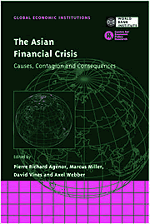Book contents
- Frontmatter
- Contents
- List of figures
- List of tables
- Preface
- List of conference participants
- Acknowledgements
- List of abbreviations and acronyms
- Introduction
- Part One General Accounts
- Part Two Theoretical Contributions
- Part Three Contagion
- 8 Contagion: monsoonal effects, spillovers and jumps between multiple equilibria
- Discussion
- 9 Contagion and trade: why are currency crises regional?
- Discussion
- 10 Competition, complementarity and contagion in East Asia
- Discussion
- Part Four Policy Responses
- Index
Discussion
from Part Three - Contagion
Published online by Cambridge University Press: 26 February 2010
- Frontmatter
- Contents
- List of figures
- List of tables
- Preface
- List of conference participants
- Acknowledgements
- List of abbreviations and acronyms
- Introduction
- Part One General Accounts
- Part Two Theoretical Contributions
- Part Three Contagion
- 8 Contagion: monsoonal effects, spillovers and jumps between multiple equilibria
- Discussion
- 9 Contagion and trade: why are currency crises regional?
- Discussion
- 10 Competition, complementarity and contagion in East Asia
- Discussion
- Part Four Policy Responses
- Index
Summary
I enjoyed reading chapter 8 because it presents a systematic and straightforward approach to modelling contagion in a currency crisis. The chapter stands in the tradition of the so-called ‘second-generation’ currency-crisis models, which originate in the work of Flood and Garber (1984) and Obstfeld (1986). In these models a self-propagating and potentially self-fulfilling speculative attack may occur even if economic fundamentals are consistent with the maintenance of a given exchange rate peg. The outbreak of the speculative attack typically involves multiple equilibria and the jump between a non-attack equilibrium and an attack equilibrium is driven by market sentiment rather than economic fundamentals. It has been stressed that such self-fulfilling speculative attacks may also have contagious effects on other currencies; for the precise modelling of these international spillovers through trade links or foreign debt accumulation, see Gerlach and Smets (1995), Buiter, Corsetti and Pesenti (1995, 1996), or Eichengreen, Rose and Wyplosz (1995).
Like the papers mentioned above, the present chapter views contagion models as a specific variant of the model of purely speculative currency crises. The key point about contagious currency crises is that the sudden swings in market expectations about future exchange rate movements are driven by the occurrence of a speculative attack in another emerging market economy. For contagion effects to work, both economies must have close economic links and/or similar economic structures. But the chapter rightly stresses that such interdependencies exist irrespective of speculative attacks, and it is important to distinguish between contagion and the other forms of interdependence.
- Type
- Chapter
- Information
- The Asian Financial CrisisCauses, Contagion and Consequences, pp. 280 - 283Publisher: Cambridge University PressPrint publication year: 1999



